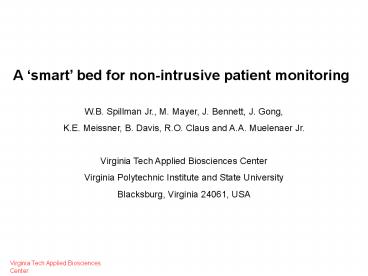A - PowerPoint PPT Presentation
1 / 15
Title:
A
Description:
Current Methods of Monitoring Patient Vital Signs Require Direct Connection ... P.R. Herczfeld et al, 'An embedded fiber optic sensor utilizing the modal power ... – PowerPoint PPT presentation
Number of Views:56
Avg rating:3.0/5.0
Title: A
1
A smart bed for non-intrusive patient
monitoring W.B. Spillman Jr., M. Mayer, J.
Bennett, J. Gong, K.E. Meissner, B. Davis, R.O.
Claus and A.A. Muelenaer Jr. Virginia Tech
Applied Biosciences Center Virginia Polytechnic
Institute and State University Blacksburg,
Virginia 24061, USA
2
Current Methods of Monitoring Patient Vital Signs
Require Direct Connection to Instrumentation
Increased amounts of automation in elder care are
becoming a critical necessity as the world
population ages.
3
Sedentary Elderly Become Vulnerable to Extremely
Painful Conditions Due to Lack of Mobility
Sedentary patients in nursing homes require
assisted movement to prevent the occurrence of
pressure induced ulcers (bed sores). If patient
movement can be remotely monitored, optimum
schedules for assisted movement can be
devised. The potential market for such a
capability is in the multi-B range.
4
The Smart Bed Concept was Developed in Response
to the Need for Non-Intrusive Automated
Monitoring of Patient Movement and Vital Signs
- A long gauge length integrating fiber optic
sensor is integrated into a standard patient bed
beneath the mattress. - Patient physical movement and movement due to
respiration and heartbeat perturb the fiber. - Modulation of the optical signal due to the
integrated mechanical perturbation of the fiber
is processed to provide the required information.
5
W.B. Spillman et al, Statistical mode sensor for
fiber optic vibration sensing applications,
Applied Optics 28, No. 15, pp. 3166-3176, 1989.
6
P.R. Herczfeld et al, An embedded fiber optic
sensor utilizing the modal power distribution
technique, J. Opt. Lett. 15, No. 21, pp.
1242-1244, 1990.
7
The Absolute Value Processing in the STM Sensor
Distorts the Power Spectrum and Low Frequency
Signals Mask Higher Frequency Signals
HOME sensor
STM sensor
8
Undergraduate Students Took Part in the Research
9
The STM Sensor Demonstrated the Ability to Detect
Patient Movement and Respiration Rate
10
The HOME Sensor Demonstrated the Ability to
Detect Patient Movement, Respiration Rate and
Heart Rate
11
The Enabling Technologies for the Smart Bed
Concept are Low Cost Computers and Wireless
Digital Cameras
12
The System Uses Cost Effective Off-the-Shelf
Hardware
nurse wearing RF ID tag
STM sensor
data is processed and activity is logged by a
central computer at the nurses station
13
Minimal Engineering Development was Required to
Create the Wireless System
14
Continuing Refinement of the System is Taking
Place
- Human body motion on beds is being modeled to
allow the spatial configuration of the sensing
fiber for optimal sensitivity to the parameters
of interest (matched filtering) to be determined. - A clinical trial of a simple one bed STM system
will be carried out in the very near future at
the Carilion Health System Sleep Center in
Roanoke Virginia. - A 6 bed multiplexed system is in the process of
being designed and fabricated. It will be
clinically tested within the next 6 months at a
Medical Facilities of America nursing home in
Roanoke Virginia. Care is being taken to insure
that the system is compatible with existing
systems already being used.
15
A Proof of Principle for Non-Intrusive Patient
Monitoring has been Carried Out
- The ability to detect patient movement,
respiration rate and heart rate has been
demonstrated. - Two different fiber optic sensing techniques
were investigated and compared. - A wireless version of the concept has been
developed using off-the-shelf cost effective
components. - Clinical trials of the concept will take place
in the very near future. - Work to refine and improve the technology
involved is on-going.































